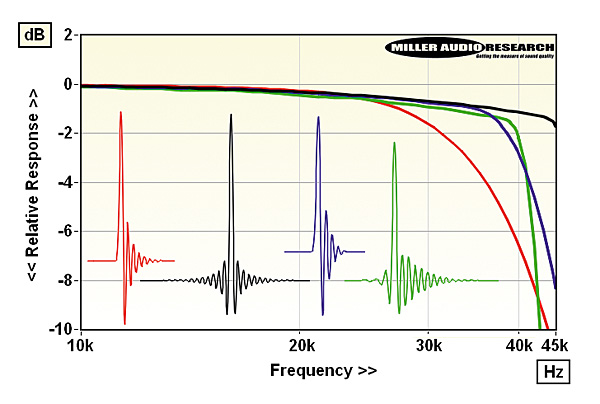Musical Fidelity M6x DAC/Headphone Amplifier A Flourish Of Filters
Inside the M6x are ES9038Q2M DACs – low consumption versions of the ES9030PRO seen in Matrix Audio's Element X [HFN Jan '21] and X-Sabre 3 [HFN Apr '22]. These chips offer the designer seven alternate digital filters – five with 'fast' (sharp) roll-off characteristics and two with 'slow' (gentler) treble roll-offs – joined here by an additional 8th 'upsample' mode. In numerical order, the filters are Fast linear phase, Slow linear phase, Fast minimum phase, Slow minimum phase, Apodising, Hybrid and Brickwall, with 'No 8' a low-overhead minimum phase filter [red traces, inset Graph]. As ever, your choice of filter influences the M6x's response, stopband rejection and time-domain distortion.

The Fast linear [black traces], Fast minimum, Apodising and Brickwall all have sharp roll-offs [the Hybrid filter, green, has a steep but early roll-off], with Slow minimum [blue] and Slow linear offering gentler treble roll-offs, reduced 'ringing' but poorer stopband rejection. Specifically, the five 'Fast' filters offer a 75-99dB rejection of digital aliasing images with 48kHz media, falling to 14-19dB with the Slow and 'No 8' filters – these are best suited to higher sample rate files. With 48kHz media the responses reach out to –0.3dB, –3.8dB, –0.4dB, –5.3dB, –1.1dB, –13dB and –4.3dB/20kHz, respectively (and –0.6dB/20kHz with 'No 8'). With 96kHz files, the 45kHz response limits are –1.8dB, –6.3dB, –1.5dB, –8.4dB, –8.9dB, –25dB, –15dB (and –11dB/45kHz for 'No 8') while, with 192kHz files, the 90kHz response limits are –4.3dB, –8.9dB, –4.1dB, –11dB, –11dB, –27dB and –17.9dB, respectively, (and –22dB/90kHz for 'No 8'). PM

























































